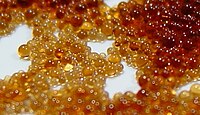
Photo from wikipedia
Abstract Removal of scale-forming ions (e.g., Ca2 +, Mg2 +) from seawater using a bioelecrochemical system (BES) was investigated in a fed-batch and a continuous mode. In the fed-batch mode, Ca2 + removal… Click to show full abstract
Abstract Removal of scale-forming ions (e.g., Ca2 +, Mg2 +) from seawater using a bioelecrochemical system (BES) was investigated in a fed-batch and a continuous mode. In the fed-batch mode, Ca2 + removal with different anolyte buffers at different external resistances (10 Ω and 1 kΩ) was evaluated. As a result, Ca2 + was effectively removed with PBS (phosphate buffer solution) and PIPES (piperazine-N,N′-bis(2-ethanesulfonic acid) buffer solution. However, the removal of Ca2 + with PBS was not solely due to current generated from the anode but also from precipitation induced by combining Ca2 + with phosphate ions transferred from the anode chamber while the removal of Ca2 + with PIPES entirely relies on a cathodic reaction. Continuous removal of Ca2 + and Mg2 + with PIPES was more effective than the fed-batch mode with removal efficiencies of > 97 ± 2% (Ca2 + removal) and 98 ± 1% (Mg2 + removal). The XRD spectra revealed that the precipitates were mainly composed of brucite (Mg(OH)2), calcite, and aragonite (CaCO3). These results indicate that BES could be a promising way to remove scale-forming ions that can promote inorganic fouling in membrane-based processes.
Journal Title: Desalination
Year Published: 2017
Link to full text (if available)
Share on Social Media: Sign Up to like & get
recommendations!